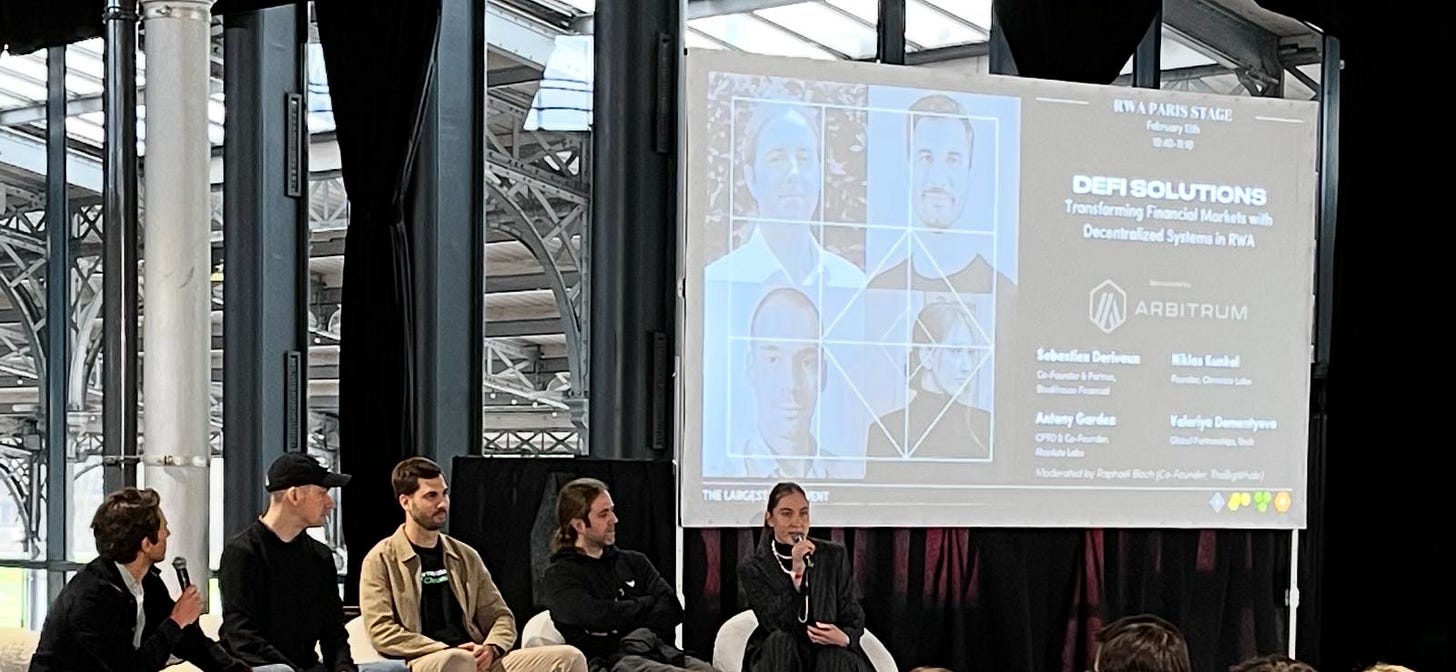Today's Agenda...
Tokenization, DePIN, AI & the NFT revival—discover the 4 key insights from NFT Paris 2025 ! 🚀 🫡
Web3 founders: are you building for the long run or playing with fire ? Understanding crypto regulation is key to survival. ⚖️🔥
⏰ Reading Time: 7 min
Join the community of web3 leaders
Strategic insights from NFT Paris 2025 : our 4-minute brief
We had the privilege of attending NFT Paris 2025 on February 13-14 at the Grande Halle de la Villette.
The event attracted over 20,000 participants and featured more than 400 speakers, underscoring its status as Europe's premier Web3 conference. For Web3 managers and C-level executives, here are four strategic takeaways to inform your business decisions:
1. Tokenization was on everyone's lips
Discussions highlighted the growing trend of tokenizing physical assets, such as real estate and commodities, to improve liquidity and broaden investment opportunities. Embracing RWA tokenization can diversify portfolios and attract a wider investor base, presenting new revenue streams for enterprises.
There were a number of very interesting panels featuring leading players in the ecosystem, such as the CEO of Hashnote, one of the biggest tokenizer of U.S. Treasury bonds.
2. Emergence of Decentralized Physical Infrastructure Networks (DePIN)
At NFT Paris 2025, a significant focus was placed on Decentralized Physical Infrastructure Networks (DePIN), highlighting their potential to revolutionize traditional industries. DePINs leverage blockchain technology to manage and facilitate physical infrastructure, creating decentralized ecosystems that were traditionally controlled by large corporations. This approach aims to enhance transparency, efficiency, and user empowerment across various sectors.
For instance, in the energy sector, DePINs can enable decentralized energy grids where consumers can trade surplus energy directly with each other, reducing reliance on centralized power suppliers. In telecommunications, decentralized networks can allow users to share bandwidth and connectivity resources, fostering more resilient and community-driven services.
3. No ! NFTs are not dead at all !
Nft's aren't dead, but they're coming back to life with a vengeance, and a number of initiatives could provide a strong dose of hype in the coming months.

I was able to attend a conference given by Luca Schnetzler, CEO of Pudgy Penguins, who gave an alpha on the fact that NFTs could soon arrive in products offered by institutions. That could make a lot of noise ! First NFT ETF ?! We will see !
4. Convergence of Generative AI and Web3
The integration of Generative Artificial Intelligence (AI) with Web3 technologies was a focal point, underscoring the transformative potential of this convergence. Several panels delved into key themes at the intersection of AI and Web3, offering valuable insights for industry leaders.
One notable panel, "AI for Public Policy and Governance: Challenges and Opportunities," examined how AI can enhance public policy and governance by addressing associated challenges and opportunities. Discussions centered on utilizing AI to analyze large datasets, improve decision-making and increase the efficiency of public services.
Another panel, "AI-Driven Security and Privacy Solutions: Protecting the Future of Decentralized Networks," highlighted the importance of AI in strengthening the security and privacy of decentralized networks. Experts discussed how AI algorithms can detect and prevent threats in real-time and proactively, ensuring the protection of data and transactions on Web3 platforms.
Additionally, the panel "AI Agents in Web3: Automating Decentralization and Empowering Users" explored the role of intelligent agents in automating decentralized processes and empowering users. Discussions focused on how these agents can facilitate interactions on Web3 platforms, making systems more accessible and efficient for businesses and individuals.
Stablecoin Payroll with Rise : Fund and Pay in USDC and USDT
Rise is completely changing global payroll by leveraging the power of blockchain and stablecoins, offering truly unique stablecoin payroll.
As the Web3 economy continues to expand, the demand for more efficient and flexible payroll solutions continues to rise just as fast.
Stablecoins, like USDC and USDT, offer an easy and efficient way to pay employees and contractors without currency exchanges, high fees, or any other common headaches.
Since these cryptocurrencies are pegged to traditional currencies, this makes them a safe and reliable form of payment without the volatility often associated with digital assets.
*commercial partnership
On the web : Entrepreneur, Profiteer, or Racketeer ? Understanding crypto regulation and its challenges
In the Web3 world, regulation is often seen as an obstacle or a threat to innovation. However, understanding its foundations and its interaction with crypto projects is essential to navigating this ecosystem. In a recent conference, a crypto and venture capital lawyer introduced a crucial analytical framework: the Entrepreneur, the Profiteer, and the Racketeer. This model helps assess a project's stance on regulatory risks and anticipate challenges in developing a crypto product.
Full video on a16z Crypto YouTube channel :
1- The nature of risk in crypto
Every crypto entrepreneur must understand that risk is inherent in their activity. Unlike other industries where regulatory compliance can be outsourced to a legal department, crypto project founders must be directly involved in risk management. Why ? Because the risks are pervasive and unique to this industry:
Strategic decisions: How to balance decentralization (which reduces regulatory risk) with operational efficiency (which increases operational risk)?
Legal compliance: A lawyer can advise on a specific legal aspect, but how does this fit into the project’s economic challenges ?
2- Crypto vs. Regulation: an inevitable conflict ?
The core issue lies in a simple observation: traditional regulations aim to oversee intermediaries that control access to financial markets. However, blockchain eliminates these intermediaries, enabling peer-to-peer transactions without a central entity.
Consider a classic example: buying Apple stock. This transaction goes through a chain of regulated intermediaries (Vanguard, a broker, a stock exchange, etc.). In contrast, buying ETH on Uniswap requires no trust in a third party, as everything is handled by a smart contract.
Philosophically, blockchain promotes a "can’t be evil" (cannot be malicious) model rather than a "don’t be evil" (should not be malicious) approach, reducing the need for regulation. However, the key question remains: at what point is a blockchain or protocol sufficiently decentralized to be exempt from traditional regulations?
3- Entrepreneur, Profiteer, or Racketeer?
The Entrepreneur
The crypto entrepreneur builds an innovative product while actively reducing the risks that regulation aims to address. They strive to create genuinely decentralized and disintermediated solutions, ensuring increased security for users.
Example: Ethereum. Although the Ethereum Foundation exists, no individual or single entity controls the network, minimizing regulatory risks.
The Profiteer
The profiteer innovates but takes shortcuts. They exploit regulatory gray areas and leverage legal uncertainty to generate profit, without genuinely protecting users from the risks regulation seeks to mitigate.
Example: A project launching a token with no real utility, solely to fuel speculation and generate quick profits.
The Racketeer
The racketeer goes a step further, blatantly violating laws while relying on regulatory uncertainty to delay or avoid repercussions.
Example: FTX before its collapse. The company projected an image of compliance while deliberately sidestepping applicable regulations.
4- Regulation : A double-edged sword
Three key truths about crypto regulation:
Regulatory uncertainty benefits profiteers and racketeers. They exploit gaps to grow quickly, at the expense of entrepreneurs and legitimate users.
An uneven playing field: Non-compliant actors operate with greater flexibility and capture market share by avoiding compliance costs.
A greater risk for users: A vague regulatory environment increases the likelihood of scams, rug pulls, and fraudulent projects.
5- Lessons for Web3 builders
Crypto entrepreneurs must adopt a pragmatic approach to regulation:
Understand fundamental regulatory principles to assess actual risks.
Avoid shortcuts that could compromise the project’s long-term viability.
Make informed decisions on key aspects like decentralization, governance, and legal structure.
Regulation is not going away, but it can be anticipated and managed wisely. The key is to do what is hard, not what is easy.
If you like our work, feel free to like and comment.
Follow us on Linkedin to keep up with all our news.
Disclaimer : The goal of this newsletter is to inform and produce content related to management in the world of Web3. It is not investment advice. Investments in crypto-assets and NFTs are risky and can result in the loss of your entire capital. Always conduct your own research and exercise caution.











Great read
Would like some love, support and feedback on my recent newsletter
https://beyondthecoin.substack.com/p/bored-apes-beeple-and-beyond-the?r=5b4atj